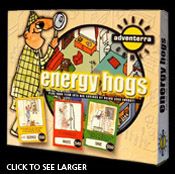

Plug your team into big savings by learning how to use less energy!
DETAILED DESCRIPTION
Energy Hogs is a one to two hour board game designed to provide an entertaining context for middle and high school kids (6th through 12th graders) and their families to learn energy conservation. While playing Energy Hogs, your objective is to make your home as energy-efficient as possible by changing your behavior and by making careful investments in new products and services. Game cards include concepts, facts, and behaviors that kids can follow in order to conserve energy at home. Players practice their reading and math skills as they play the game, learning useful vocabulary and calculating payback ratios.


The game board consists of a cutaway view of a house and a commercial zone nearby. Playacations.
How to win the game as individuals
As individuals each of you wins by choosing the right strategy, acquiring and playing cards with the most A-bucks worth of energy saved and the least A-bucks worth of energy wasted.
How to win the game as a team
Your team consists of all four of you playing on the same board at one time. Your team wins by saving the most total A-bucks on energy, net of total A-bucks wasted on energy. When playing at home, you can benchmark against previous high team scores for energy conservation. In a classroom or camp setting, teams compete against each other. When more than one team is playing at the same time, the team with the highest positive score wins the Energy Misers team prize and the team with the highest negative or the lowest positive score wins the Energy Hogs booby prize.
The Teacher’s Manual
The Teacher’s Manual contains a narrative and statistics explaining the history of energy use, the various sources of energy and consumption patterns, and the connection between saving energy, reducing CO2 emissions, and slowing the rate of global warming.
Post-game action: Saving real energy to save the planet!
During the hour or two that it takes to play Energy Hogs, players should write down some of the energy-savings ideas from the game that they can adopt in their real homes to reduce pollution and slow global warming while saving their families real money! When players finish the game they can agree on a timetable for implementing this action list!
List of Energy Hogs components
- Game boxGame board (mounted on thick cardboard)
- Five decks of behavioral cards, each set in a different room of the house. These cards are split between (green) Save cards and (red) Waste cards representing behaviors that players can do or not do at home.
- Three decks of Services cards.
- Four colored wooden movement tokens and four matching-colored Energy Smart buttons designed to record visits to the Community Energy Awareness Office.
- Two wooden dice.
- A supplemental guidebook for teachers and parents.
- A-bucks (fake money) in various denominations.
- A brief questionnaire soliciting feedback on how to improve the game.
Now kids can learn how to use our resources more efficiently and become a cure to our problems!
ice and moving along the path connecting the house to various shopping centers and offices, drawing and playing energy-saving and energy-wasting cards as they arrive at locations.
How to win the game as individuals
As individuals each of you wins by choosing the right strategy, acquiring and playing cards with the most A-bucks worth of energy saved and the least A-bucks worth of energy wasted.
How to win the game as a team
Your team consists of all four of you playing on the same board at one time. Your team wins by saving the most total A-bucks on energy, net of total A-bucks wasted on energy. When playing at home, you can benchmark against previous high team scores for energy conservation. In a classroom or camp setting, teams compete against each other. When more than one team is playing at the same time, the team with the highest positive score wins the Energy Misers team prize and the team with the highest negative or the lowest positive score wins the Energy Hogs booby prize.
The Teacher’s Manual
The Teacher’s Manual contains a narrative and statistics explaining the history of energy use, the various sources of energy and consumption patterns, and the connection between saving energy, reducing CO2 emissions, and slowing the rate of global warming.
Post-game action: Saving real energy to save the planet!
During the hour or two that it takes to play Energy Hogs, players should write down some of the energy-savings ideas from the game that they can adopt in their real homes to reduce pollution and slow global warming while saving their families real money! When players finish the game they can agree on a timetable for implementing this action list!
List of Energy Hogs components
- Game boxGame board (mounted on thick cardboard)
- Five decks of behavioral cards, each set in a different room of the house. These cards are split between (green) Save cards and (red) Waste cards representing behaviors that players can do or not do at home.
- Three decks of Services cards.
- Four colored wooden movement tokens and four matching-colored Energy Smart buttons designed to record visits to the Community Energy Awareness Office.
- Two wooden dice.
- A supplemental guidebook for teachers and parents.
- A-bucks (fake money) in various denominations.
- A brief questionnaire soliciting feedback on how to improve the game.
Now kids can learn how to use our resources more efficiently and become a cure to our problems!
